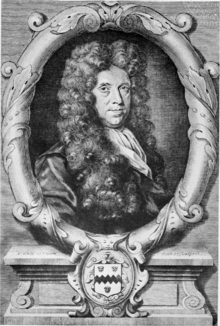尼希米·格鲁
尼希米·格鲁(英语:Nehemiah Grew;1641年9月26日—1712年3月25日),是一名英格兰的植物学家、博物学家和解剖学家,和义籍生物学家马切洛·马尔皮基共同被誉为植物解剖学的开创者。
| 尼希米·格鲁 Nehemiah Grew | |
|---|---|
 尼希米·格鲁的木刻画像 | |
| 性别 | 男性 |
| 出生 | 1641年9月26日 |
| 逝世 | 1712年3月25日(70岁) |
| 国籍 | |
| 母校 | 剑桥大学彭布罗克学院、莱顿大学 |
| 机构 | 皇家学会 |
| 知名于 | 开创植物解剖学、发现并命名薄壁细胞、研究人类指纹 |
| 研究领域 | 植物解剖学、博物学 |
生平
编辑早年生活
编辑尼希米·格鲁出生于英格兰沃里克郡的考文垂(考文垂现属西密德兰郡),是奥巴迪亚·格鲁(Obadiah Grew)的儿子。奥巴迪亚是考文垂圣米歇尔教区的清教徒牧师及学者。英格兰内战期间,奥巴迪亚支持圆颅党,但据说他曾恳求克伦威尔饶恕国王查理一世的性命。[1][2][3]
格鲁有位同父异母的哥哥亨利·桑普森(Henry Sampson),两兄弟的感情很好。[2][3]
1658年,格鲁进入剑桥大学的彭布罗克学院就读。大约在1664年时,他开始研究植物的生理学;几年后,他向桑普森展示了自己的成果。桑普森当时在帕多瓦和莱顿攻读医学,他鼓励格鲁继续研究,并介绍他阅读英格兰解剖学家弗朗西斯·格里森(Francis Glisson)的著作。[3]
1671年,格鲁前往荷兰莱顿攻读医学博士学位,其学位论文为《论神经液体(De Liquor Nervoso)》。[3][4]
职业生涯
编辑1670年,在格鲁的同意下,桑普森向英国皇家学会的秘书亨利·奥尔登堡(Henry Oldenburg)递交了格鲁的植物学论文《蔬菜解剖学初论》(The Anatomy of Vegetables Begun),奥尔登堡又把它转交给威尔金斯主教,威尔金斯则在皇家学会的会议上宣读了这篇文章。这篇论文使格鲁获选为皇家学会院士,并于1672年印刷。[3][4]
1672年4月,格鲁受指派担任皇家学会收藏品的管理者(curator),负责看管学会的稀有藏品及实验器材。他偶尔也会协助同样担任此职务的罗伯特·虎克进行示范实验和演讲。[2]
1677年,奥尔登堡过世,格鲁和虎克接替了他身为皇家学会秘书的工作。格鲁在1678到1679年间负责编撰学会的刊物《自然科学会报》,并和欧洲各地的学者通信。[3][4][5]
1678年7月,格鲁受指派负责为皇家学会典藏库( the Royal Society' s Repository)中的物品编目。隔年,他出版了《皇家学会博物馆目录》(Musaeum Regalis Societatis)。与此同时,他自己长年来的植物学研究成果也汇集成《植物解剖学》出版。[1][3][4]
个人生活
编辑格鲁一生中结过两次婚,第一次在1670年代末,第二次则在1685年、第一任妻子过世后不久,他和伊丽莎白·道森(Elizabeth Dodson)再婚。格鲁至少育有二女一子。[4]
主要著作与科学贡献
编辑植物学
编辑《蔬菜解剖学初论》
编辑在《蔬菜解剖学初论》里,格鲁详加讨论了植物萌芽的历程和外观特征,并发明了胚根(radicle)一词。[1]
在格鲁投入植物学研究之前,英国大部分的植物学相关研究皆较少注意植物作为草药以外的功能和特色。身为医生,格鲁拥有丰富的解剖学知识,这引发他开始尝试把植物当作解剖的对象。[1]
当时关于动物的解剖研究非常繁盛,但却从未有以植物为主题的类似研究。然而,格鲁信心满满地写道:
……考虑到[动物和植物]两者皆出自同一双手,而因此是同一智慧的造物;由此,我能充分向自己保证,尽管可能不成功,但在两者中寻求[上帝]不可能是徒劳的尝试。(... considering that both came at first out of the same Hand, and are therefore the Contrivances of the same Wisdom; I thence fully assured my self, that it could not be a vain Design, though possibly unsuccessful, to seek it in both.)[1][6]
在格鲁的论文出版的同一天,皇家学会也收到了马切洛·马尔皮基的植物学手稿。格鲁先前就已向学会提交自己的作品,因此保有优先权;但是后世的植物学史家如许来登仍对格鲁作品的原创性提出质疑,暗示格鲁可能抄袭了马尔皮基的成果。然而,考量到格鲁在本书的二版前言中列明了马尔皮基的贡献,因此指控不太可能为真。较可信的说法是两人分别独立发展了自己的植物解剖研究。[1][2] 为马尔皮基作传的历史学家Howard B. Adelmann如此评论格鲁和马尔皮基的关系:
在他们的工作完成之前的这些年里,他们的关系只有礼貌、相互尊重和对彼此努力的慷慨赞赏。(nothing but courtesy, mutual respect and generous appreciation of one another's efforts marked their relations in the years that passed till the completion of their work.)[2]
《蔬菜解剖学初论》之后,格鲁又写了几篇论文讨论植物的根和茎的结构,这些论述最后发展成为《植物解剖学》(Anatomy of plants)的内容。[1]
《植物解剖学》
编辑博物学
编辑《皇家学会博物馆目录》
编辑皇家学会典藏库(the Royal Society' s Repository)在学会创立不久后成立,旨在保存学会的科学仪器、书籍、文件及稀有收藏等等。典藏库本身位于格雷瑟姆学院(Gresham college),皇家学会成员聚会的会议室亦在学院中。[7]
由于典藏库中的藏品长年缺乏妥善管理,1678年7月,皇家学会主席汤玛斯·亨肖(Thomas Henshaw)指派格鲁负责为典藏库中的物品编目,并在隔年出版了《皇家学会博物馆目录》(Musaeum Regalis Societatis)。[8]
人体生理学
编辑指纹
编辑1684年,格鲁发表了〈手和脚上的皮肤毛孔之描述及用途(The description and use of the pores in the skin of the hands and feet)〉一文,并刊载在《自然哲学会报》上。该文是欧洲科学史上首次对指纹的描述。[9][10]
形而上学
编辑《神圣宇宙论》
编辑作品列表
编辑参考资料
编辑- ^ 1.0 1.1 1.2 1.3 1.4 1.5 1.6 Oliver, Francis Wall. Nehemiah Grew 1641—1712 by Agnes Arber. Makers of British botany; a collection of biographies by living botanists. Cambridge: University press. 1913 [2023-08-25]. doi:10.1017/CBO9780511710902. (原始内容存档于2023-08-25).
- ^ 2.0 2.1 2.2 2.3 2.4 Lefanu, William R. The Versatile Nehemiah Grew. Proceedings of the American Philosophical Society. 1971, 115 (6) [2023-08-25]. ISSN 0003-049X. (原始内容存档于2023-08-25).
- ^ 3.0 3.1 3.2 3.3 3.4 3.5 3.6 Early problems in professionalizing scientific research: Nehemiah Grew (1641-1712) and the Royal Society, with an unpublished letter to Henry Oldenburg. Notes and Records of the Royal Society of London. 1982-02-28, 36 (2) [2023-08-25]. ISSN 0035-9149. doi:10.1098/rsnr.1982.0011. (原始内容存档于2022-08-26) (英语).
- ^ 4.0 4.1 4.2 4.3 4.4 Stephen, Leslie; Lee, Sir Sidney. Volume 8. The Dictionary of National Biography. Oxford University Press. 1908: 609–611 [2023-08-25]. (原始内容存档于2023-08-25) (英语).
- ^ Nehemiah Grew | Lens on Leeuwenhoek. lensonleeuwenhoek.net. [2023-08-27]. (原始内容存档于2023-09-28).
- ^ Grew, Nehemiah. The Anatomy of Vegetables Begun, With a General Account of Vegetation founded thereon. London: Printed for S. Hickman. 1672 [2023-08-27]. (原始内容存档于2023-08-27).
- ^ Williams, Grant (编). Thomas Sprat, The History of the Royal Society (1667). The Memory Arts in Renaissance England: A Critical Anthology. Cambridge: Cambridge University Press. 2016: 168–171 [2023-09-27]. ISBN 978-1-107-08681-4. doi:10.1017/cbo9781316091722.034. (原始内容存档于2018-06-17).
- ^ Grew, Nehemiah. Musaeum Regalis Societatis, or, A catalogue & description of the natural and artificial rarities belonging to the Royal Society and preserved at Gresham Colledge. London: Printed by W. Rawlins, for the author. 1681 [2023-09-27]. doi:10.5962/bhl.title.105136. (原始内容存档于2023-11-13).
- ^ Caplan, Richard M. How fingerprints came into use for personal identification. Journal of the American Academy of Dermatology. 1990-07, 23 (1). ISSN 0190-9622. doi:10.1016/0190-9622(90)70194-m.
- ^ Grew, Nehemiah. The description and use of the pores in the skin of the bands and feet, by the learned and ingenious Nehemiah Grew, M. D. Fellow of the College of physicians and of the Royal Society. Philosophical Transactions of the Royal Society of London. 1684-05-20, 14 (159) [2023-09-27]. ISSN 0261-0523. doi:10.1098/rstl.1684.0028. (原始内容存档于2022-03-19) (英语).
外部链接
编辑- 尼希米·格鲁在古腾堡计划中的作品列表
- 《皇家学会博物馆目录》 (页面存档备份,存于互联网档案馆),在密歇根大学的早期英文书文本计划 (页面存档备份,存于互联网档案馆)中的文本
- 尼希米·格魯. Encyclopædia Britannica XI 9th: 189. 1880.
- Stephen, Leslie and Lee, Sidney (编). 尼希米·格魯. Dictionary of National Biography 23. London: Smith, Elder & Co. 1890.